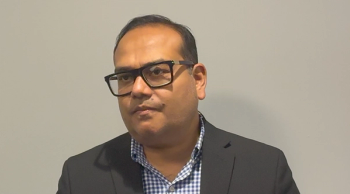
Oncology NEWS International
- Oncology NEWS International Vol 10 No 5
- Volume 10
- Issue 5
Goserelin Equal to Adjuvant Chemo in Early ER+ Breast Cancer
SAN ANTONIO-The gonadotropin hormone-releasing hormone agonist analog goserelin (Zoladex) is an alternative to adjuvant chemotherapy for women with early breast cancer who are pre- or perimenopausal and have estrogen-receptor (ER)-positive tumors, said Walter Jonat, MD, of the University of Kiel, Germany. He spoke at the 23rd Annual San Antonio Breast Cancer Symposium on behalf of the Zoladex Early Breast Cancer Research Association (ZEBRA).
SAN ANTONIOThe gonadotropin hormone-releasing hormone agonist analog goserelin (Zoladex) is an alternative to adjuvant chemotherapy for women with early breast cancer who are pre- or perimenopausal and have estrogen-receptor (ER)-positive tumors, said Walter Jonat, MD, of the University of Kiel, Germany. He spoke at the 23rd Annual San Antonio Breast Cancer Symposium on behalf of the Zoladex Early Breast Cancer Research Association (ZEBRA).
The survival results in ER-positive and ER-negative patients were analyzed separately. In ER-positive patients, goserelin was found to be equivalent to cyclophosphamide, methotrexate and fluorouracil (CMF) in terms of disease-free survival (hazard ratio, 0.99) but without chemotherapy’s harsh side effects.
Overall survival with goserelin in the ER-positive patients mirrors that of CMF, but mature data are needed to verify this finding, Dr. Jonat said.
In ER-negative-patients, as expected, the hazard ratio for disease-free survival was in favor of CMF (1.72).
The study followed 1,640 women from 102 centers in 15 countries who were enrolled between October 1, 1990 and December 30, 1996. Patients were randomized to receive either 3.6 mg of goserelin (n = 817) or six cycles of CMF (n = 823). Prognostic factors were well balanced between the groups.
Bone Mineral Density
Patients who received goserelin had better long-term preservation of bone mineral density (BMD). Bone mineral density was lost during treatment in both groups, but was partially recovered in the goserelin patients after treatment was finished. In contrast, the CMF patients experienced ongoing BMD loss after the conclusion of treatment.
"Ovarian suppression resulting in amenorrhea is associated with bone mineral density loss," Dr. Jonat said.
About 95% of patients who received goserelin became amenorrheic during the 2-year treatment period. In contrast, 60.2% and 71.7% of the CMF patients were amenorrheic at 24 weeks and 2 years, respectively. However, at 3 years, menses had returned in the majority of patients taking goserelin, and only 37.8% were amenorrheic. By comparison, 79% of patients who received CMF were amenorrheic at 3 years.
Patients who received goserelin also reported significantly better scores for overall quality of life, as well as activity level, physical distress, and efforts to cope with illness at 3 and 6 months when compared with patients who received CMF. This coincides with the CMF treatment period. However, no significant difference in overall quality of life between the two groups was seen after 6 months, Dr. Jonat commented.
Patients ranked the two therapies as comparable for psychological distress and social effects. In evaluations of hormonal effects (hot flushes and vaginal dryness) over the first 2 years, women scored CMF significantly better than goserelin, but at 3 years, after the conclusion of goserelin treatment, that finding was reversed, with goserelin rated better.
Articles in this issue
over 24 years ago
Adjuvant Chemo Dose Reductions Frequent in Breast Cancerover 24 years ago
Women May Be at Greater Risk for Undertreatment of Cancer Painover 24 years ago
Umbilical Cord Blood in Adult Leukemia Patientsover 24 years ago
Irinotecan Results Continue to Be Encouraging in Colorectal Cancerover 24 years ago
Irinotecan Active in Pediatric Cancersover 24 years ago
Ultrasound Contrast Agents Help Diagnose Prostate Cancerover 24 years ago
Optimal Use of Irinotecan Still to be Determinedover 24 years ago
Groups Urge Federal Action Against Eclipse Cigarettesover 24 years ago
Potential Advantages of Oral Irinotecan Defined in Phase I StudiesNewsletter
Stay up to date on recent advances in the multidisciplinary approach to cancer.



















































































